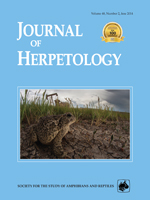Several observational and experimental studies have shown that perch diameter has an impact on the development of hind-limb length (HL) in Anolis species. This “phenotypic plasticity” in relative hind-limb growth (RHG) has implications for short-term and long-term adaptation to different structural habitats. Our study is the first to replicate research in which hatchling/juvenile Anolis sagrei were reared on narrow-diameter or broad-diameter dowels in a laboratory setting. Although subjects reared on different dowel diameters did not differ significantly in RHG at 5 weeks into the experiment, results at 15 weeks revealed a significant effect of treatment but not of sex: subjects in the broad (N = 69) treatment group exhibited significantly greater RHG than did subjects in the narrow (N = 61) treatment group. We extended this research with a novel follow-up study: we placed our lab-reared subjects into outdoor enclosures where they had a choice of narrow- or broad-diameter dowels on which to perch. Results showed that subjects in both treatment groups chose broad-diameter dowels as perches more often than narrow-diameter dowels. We offer several potential explanations for the strong preference of our subjects for broad-diameter dowels irrespective of the dowel diameter on which they were reared.
BioOne.org will be down briefly for maintenance on 17 December 2024 between 18:00-22:00 Pacific Time US. We apologize for any inconvenience.
How to translate text using browser tools
1 June 2014
Phenotypic Plasticity in the Relative Hind-Limb Growth of Lab-Reared Anolis sagrei: Replication of Experimental Results and a Test of Perch Diameter Preference
Gabriel J. Langford,
Joseph M. Macedonia,
Christopher W. Bessette,
Jennifer L. Matey,
Brittany A. Raboin,
Ashley E. Schiffmacher,
Brett J. Reynolds
ACCESS THE FULL ARTICLE

Journal of Herpetology
Vol. 48 • No. 2
June 2014
Vol. 48 • No. 2
June 2014




